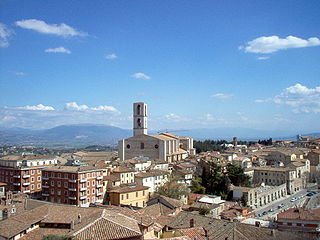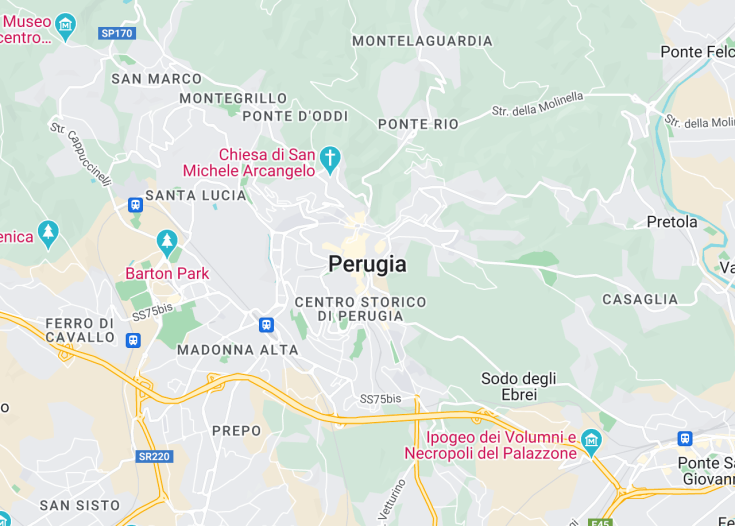Perugia, the capital city of Umbria in central Italy, epitomizes the cultural richness and historical depth of the country. This medieval city, ensconced atop a hill, offers breathtaking views and is wrapped in ancient walls. Renowned for its universities and vibrant cultural scene, Perugia is also famous for its chocolate. The city’s historical architecture, from the Gothic Perugia Cathedral to the Palazzo dei Priori, art enthusiasts and history seekers are in for a treat. The Umbria Jazz Festival, held every July, turns the city into a hub of international music, attracting visitors from all corners of the globe.
When visiting Perugia, start at the Piazza IV Novembre; it’s the heart of the city and offers a spectacular mix of art, architecture, and lively cafes.
Consider timing your visit to coincide with the Umbria Jazz Festival for a truly dynamic experience of this city’s vibrant cultural scene.
Top things to do & see in Perugia
Select the following sights and activities to discover best tickets and tours available in Perugia.
Exploring Perugia: Heart of Umbria
| Country | Italy |
| Time in Perugia | GMT+1 |
| Language spoken | Italian |
| Population | 166,676 (As per latest data source) |
| Currency | Euro (€, EUR) |
| Airports |
|
Perugia, a gem nestled in the heart of Italy’s Umbria region, boasts a rich tapestry of history dating back to the Etruscan period. This city, perched atop a hill, offers breathtaking views of the lush Italian countryside and is cloaked in well-preserved medieval charm. Perugia’s historical architecture, from its ancient walls and gates to the grand Palazzo dei Priori, tells tales of a past filled with artistic glory and political might. Recognized for its cultural contributions, Perugia houses one of Italy’s oldest universities, the University of Perugia established in 1308, breathing an air of youthful vibrance into its ancient streets. The city is a cultural hub, hosting the renowned Umbria Jazz Festival every July, which attracts music lovers worldwide. The gastronomic offerings of Perugia add another layer to its allure. The city is synonymous with chocolate, primarily due to the famous ‘Baci’ chocolates produced by local confectioner Perugina. These chocolates, known worldwide, highlight the city’s culinary craftsmanship. Perugia also serves as an ideal base for exploring the serene Umbrian landscape, with its proximity to rolling hills, vineyards, and historical towns like Assisi and Spello. The blend of cultural richness, historical significance, and natural beauty makes Perugia a captivating destination for travelers who wish to experience the essence of Italy.
Where is Perugia?
Perugia is situated in central Italy, nestled amid the rolling hills of Umbria.
Distances:
| Route | Distance by car | Time by car |
|---|---|---|
| Rome to Perugia | 105 miles (170 km) | 2 hours 20 minutes |
| Florence to Perugia | 92 miles (148 km) | 1 hour 40 minutes |
| Milan to Perugia | 248 miles (400 km) | 4 hours 10 minutes |
What is Perugia famous for?
Perugia is renowned for its rich history, including the well-preserved medieval architecture, prestigious University of Perugia, and as a vibrant cultural center, notably hosting the Umbria Jazz Festival.
History
Pre-Roman and Roman Era
Perugia’s history dates back to the Etruscan period, with the first settlements believed to have been established around the 9th to 8th century BC. It became one of the major Etruscan city-states by the 4th century BC. The city was known as Perusia back then, a testament to its strength and influence, especially during the wars against Rome. However, ultimately in 40 BC, after a lengthy siege, it was captured by Roman forces under the command of Octavian (later known as Augustus), marking the beginning of Roman domination.
Medieval Perugia
In the Medieval period, Perugia became a significant artistic and cultural center. The city-state was governed by aristocratic families and later by a series of tyrants, among them the famous condottieri Braccio da Montone. During this era, Perugia was often at war with neighboring cities and was a fierce competitor in the power struggles of central Italy. The city was a critical player in the Guelph and Ghibelline conflicts, aligning itself mostly with the Guelphs against the Holy Roman Empire.
Renaissance Bloom
The city flourished during the Renaissance, becoming a hub for art, architecture, and culture. Artists like Pietro Perugino, who taught Raphael, were active in the city during this time. This period in the history of Perugia is marked by the construction of beautiful buildings and an increase in the patronage of the arts, reflecting the city’s prosperity.
Modern Era
Through the centuries leading up to the present day, Perugia faced numerous challenges, including foreign invasion, plagues, and economic downturns. It became part of the unified Kingdom of Italy in 1860. Today, Perugia is renowned for its historical legacy, reflected in its extensive array of archaeological and architectural treasures. It is also home to the University of Perugia, established in 1308, which continues to be an important center of learning.
Visit Perugia
What to see and do in Perugia
Explore the rich history and vibrant culture of Perugia by visiting its numerous historical monuments and museums. Highlights include the Palazzo dei Priori, a medieval palace that now houses the National Gallery of Umbria with its fine collection of Renaissance art. Don’t miss the Gothic cathedral of San Lorenzo and the ancient Etruscan Arch. Walking through the city’s cobbled streets, visitors can marvel at the well-preserved fortifications and gates that outline the old city.
- Visit the Fontana Maggiore, a stunning medieval fountain decorated with biblical scenes and zodiac signs.
- Explore the underground city through Rocca Paolina fortress, showcasing Perugia’s layers of history.
- Enjoy the local cuisine, which includes delicious chocolates and the unique torta al testo.
Events in Perugia
Perugia hosts several notable events throughout the year. Perhaps the most famous is the Umbria Jazz Festival, held every July. This internationally renowned festival attracts world-class jazz performers. Another significant event is the Eurochocolate, an annual chocolate festival occurring in October, where the city transforms into a chocoholic’s paradise.
Best time to visit Perugia
The best time to visit Perugia is either in the spring (April to June) or fall (September to October). During these months, the weather is pleasantly mild, and the city is less crowded, allowing for a more relaxed exploration of its historical and cultural sites.
Is Perugia worth visiting?
Perugia is definitely worth visiting for anyone interested in Italian history, arts, and cuisine. The city offers a unique blend of ancient and medieval architecture, world-class museums, and cultural festivities that are sure to enrich any traveler’s experience. Additionally, its scenic views and local culinary delights provide a delightful backdrop to an enriching cultural journey.









